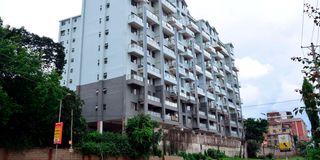Breaking News: Former Lugari MP Cyrus Jirongo dies in a road crash

High-rise apartments in Kileleshwa, Nairobi.
Nairobi Governor Johnson Sakaja at the weekend broke the hearts of some with very strong statements —that the construction of highrise apartments in the Kenyan capital’s upmarket neighbourhoods of Kileleshwa and Lavington will not stop.
“I have heard people complaining that [in the] areas of Kileleshwa and Lavington, our homes were one-storey, now apartments have come. Nairobi is 696 square-kilometres. In 2050, it will have a population of 10.5 million. Will we expand Nairobi? No, the only place we have to go is up,” he said.
The highrise sprawl is spreading like wildfire to several other suburbs beyond Kileleshwa and Lavington with water and mobility infrastructure already severely stressed under the weight of it all.
Yet, despite the horror of urban minimalists and purists, Sakaja’s vision of a Nairobi consumed by highrises is the more likely fate of the city.
This is so when you consider that his figure of 10.5 million people in Nairobi by 2050 is drawn from conservative projections. Some estimates have the population of Nairobi in 2050 at a high of 14.2 million, when the population of Kenya will be 85 million.
Sakaja has another option that he didn’t explore: To go underground, as cities like Hong Kong, Taipei, Seoul, Shanghai and Helsinki, with very tight spaces left above, are doing.
This is especially so for infrastructure like roads, railways, parking and storage, freeing the areas they eat on the ground for housing and office.
However, with our proclivity for shoddy work and cutting corners, going underground in Africa is still seen as risky business. You might not come out from down there alive.
A Nairobi of 10.5 million people darkened by highrises is not destined to end in a dystopian nightmare. It could also be a pot of gold.
As we have reported before, it could be part of a dramatic transformation of the 21st century in which cities supplant countries as the platforms on which new economic and political global orders are organised.
It is projected that 68 per cent of the world’s population will be living in urban areas by 2050 with only 32 per cent scattered in the villages and rural areas. Heaving with millions of people, Nairobi, not Kenya, would trade with Kampala and Mumbai, not Uganda and India.
A lot more political power will be concentrated in Nairobi, too, so if Parliament is elected based on population, the city would have at least 12 per cent of the seats in the Legislature.
In presidential elections, if you cleaned out Nairobi, you would need to win one populous region (say the Luhya vote), then steal a few here votes and there and you are home and dry.
Even more significantly, as suggested earlier, Nairobi would exist in a global and pan-African context. Africa currently has three cities with at least 10 million people, known as megacities: Cairo in Egypt, Kinshasa in the Democratic Republic of Congo (DRC) and Lagos in Nigeria.
According to an influential 2017 report by the think tank Institute for Economics & Peace, by 2050, in addition to Nairobi, Africa will have three more megacities: Dar es Salaam, Tanzania’s commercial capital; Khartoum in Sudan (although the current war there wasn’t foreseen and the city might be no more by then); and Luanda, the capital of Angola.
The Institute for Economics & Peace had Dar seeing the biggest growth of the four cities, its population soaring by 118 per cent to 16.4 million. Nairobi would have grown by 100 per cent, to get to Sakaja’s 10.4 million.
Overall, Cairo will have the biggest population, with a predicted 32.6 million people, followed by Kinshasa with 29 million and Lagos 28.2 million.
With cities also being mega economic hubs, that would be a big concentration of wealth to the eastern half of Africa, as only Lagos and Luanda would be outside the region.
The parent of an East African child who is in primary school today, or a new start-up, would do well to think of how very different the world of 2050 will be.
It can be as simple as thinking ahead to how these cities will be provided with water. Rivers and lakes won’t be enough.
Within Kenya, the population of Mombasa is projected to be as high then as Nairobi’s today, with about 4.3 million on the higher end.
The next three biggest cities — Kisumu, Nakuru and Eldoret (in no particular order) — are projected to have at least three million people each.
Notably, all these cities are along the Northern Corridor, which is already fairly urbanised. It means that one would drive essentially along an unbroken urban 4,500 kilometres stretch southwards from Mombasa through Tanzania to Kinshasa. Or about 4,000 kilometres northwards through Uganda.
In terms of governance, present approaches will not do. We might be headed for times when we get visas issued by cities, not countries. Where the mayor of a rich megacity is as important as the president of the country.
Sakaja did us a favour: He released the proverbial canary in the coal mine.
Mr Onyango-Obbo is a journalist, writer and curator of the “Wall of Great Africans”. @cobbo3










